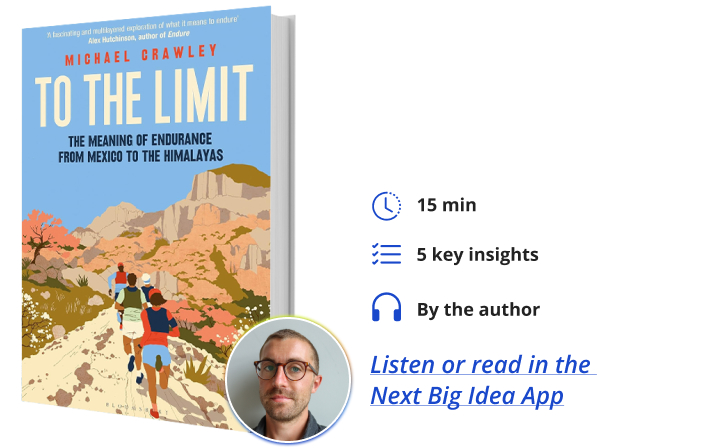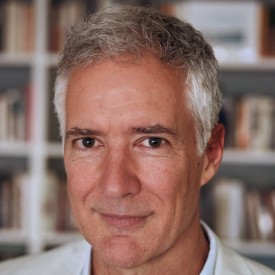Michael Crawley is a social anthropologist, writer, and endurance athlete based at Durham University. His book Out of Thin Air won the Margaret Mead Award in 2022. He has written for the Guardian, Runners’ World, and Trail Running.
What’s the big idea?
Endurance sports are often perceived as a solitary pursuit to discover how far a human body can push and overcome. Though individual fitness is an impressive element of endurance, the question of how far can we go? may not be as important as why do we go so far? Cultural motivators for endurance athletes speak volumes about the heartbeat of a community.
Below, Michael shares five key insights from his new book, To the Limit: The Meaning of Endurance from Mexico to the Himalayas. Listen to the audio version—read by Michael himself—in the Next Big Idea App.

1. Endurance sport tends to be popular at times of societal change.
For a couple of decades in the mid to late 19th century, there was a sport so popular that tens of thousands of spectators crowded venues in America and England for an entire week. The sport was so significant that a contest in 1879 heralded the first time that electric lighting had been put to popular use. Gilmore’s Garden in New York was so crowded that a balcony collapsed under the weight of the wealthier spectators. The sport that captured such frenzied attention was walking, with the most popular contests taking place over six days, with participants barely sleeping and sustaining themselves on such things as beef tea, egg yolks, and champagne.
These races took place at a time of profound change, when walking to places was becoming replaced by driving, and machines were more generally beginning to replace people. As a journalist for the Virginia Quarterly Review put it at the time, “It seemed as though the muscles of the nation were making one final, vast, collective effort before being replaced by the internal combustion engine.” It is tempting to wonder whether the current boom in endurance sports is motivated by contemporary worries about the rise of AI. Running or cycling all day seems to be a way of screaming out that we are still uniquely human, that there are things we can do and experience that can’t be replaced by technology.
2. Enduring together creates unusually strong social bonds.
After running for over 13 hours at an ultra-marathon, I sat on the ground watching people finish the race until after midnight. Most new arrivals came in pairs or small groups rather than alone. “Oh mate, thank you,” one man said, wrapping his arms around his companion in a sweaty embrace that made it seem like they had known each other for years, before adding “Nice to meet you.” It turned out they had met an hour or so before, on the dark fellside. “It’s incredible the bond you can create over 20km of an ultra,” is how one person put it.
“There are things we can do and experience that can’t be replaced by technology.”
I also experienced this when cycling 100 miles overnight from Carlisle to Crammond in the U.K.’s Ride to the Sun event; something about covering long distances connects us. As the historian William H. McNeil puts it, “moving our muscles rhythmically […] consolidates human solidarity by altering human feelings.” This was probably an important part of bringing communities together in the past, and we can recreate it through endurance challenges.
While we often think of activities like running as primarily individualistic pursuits, many of the world’s top athletes see them differently. For instance, in Ethiopia, I found that runners understand success to be collectively produced and energy to be something that must be shared as equally as possible. “Running alone is just for health,” I was told; to improve, “you have to run with others.”
3. The best endurance athletes embrace technology carefully.
When Tao Geoghegan-Hart won the Giro D’Italia in 2020, he had not even started the race as Ineos Grenadiers’ main General Classification contender. Speaking about his first stage victory at the ski station finish at Piancavallo, he told me about looking at his bike computer on his way up. “I remember a point where I saw some stuff on the screen and I was conscious of how high it had been for such a long time, and I kind of decided to tune out of it, because I was feeling really good. In some moments, you just have to trust your intuition and your feeling,” he said.
At a time when there are ever-increasing opportunities to track more variables—from watts and heart rate variability to blood glucose—it is interesting to note that many of the best athletes are very selective about when and how they record data on themselves. “I don’t think there are many people in the world for whom having more and more numbers dictating how they live their lives is going to be beneficial,” is how Tao put it. Companies like Whoop and Oura may well give us privileged insights into what is going on in our bodies that may be performance enhancing, but it is worth considering whether an over-reliance on this kind of data might blunt our ability to run or ride on feel as Tao did on Piancavallo.
There are many important things that we can’t track. If you focus too much on the data, “anything that isn’t quantifiable gets removed from the picture,” Tao says. “But our emotions and our experiences as humans—we aren’t robots—actually determine far more about our performance than anything else.”
4. Cultural explanations of success in endurance sports are important.
Many of the endurance cultures I studied have been assumed to have some genetic or altitude-derived advantage. A CNN article from 2016 entitled “The Biological Secrets that Make Sherpas Superhuman Mountaineers” claimed that sherpas are able to scale Himalayan mountains “with ease.” Similar assumptions are often made about Ethiopian and Rarámuri runners, claiming that superior genetics make running come naturally to them, despite there being no scientific proof of this.
“There are many important things that we can’t track.”
This downplays the hard work and expertise involved in running at the top level or guiding hapless clients up Everest. It also fails to account for the cultural reasons why people do hard things. For Rarámuri runners in Mexico, races are explicitly about bringing communities together, and running for a long time is seen as a form of prayer, a way of pleasing God and keeping the Earth turning on its axis.
5. Connect what you are doing to something bigger than yourself.
Whilst the current focus on data and technology tends to make endurance sport about the individual, it seems to help people if they can connect what they are doing to something bigger. For the trail runners I knew in Nepal, this meant connecting their aspirations to run internationally to other ways in which Nepalese people have demonstrated physical prowess on the world stage, primarily by becoming a Gurkha in the British army. Many trail runners train for the Gurkha trials first, often by running up mountains while carrying heavy loads on their backs. Being a Gurkha was a way to ensure your name was never forgotten, and the same was true of becoming an athlete. “The name of the athlete is greatest of all,” I was told by a young runner called Lopsang.
For many others, endurance sport has become a way of delivering a message about climate change. Lewis Pugh, the UN Patron of the Oceans, argued that many people develop an environmental consciousness by spending long periods of time moving through nature, and often suffering in the process. For him, there is a clear symbolic value in doing challenging and risky things that draw attention to the planet’s fragility. His one-kilometer swim in supra-glacial Antarctic water had a genuine effect on the negotiations to secure a protected area there with Russia and China.
On a smaller scale, our efforts to replace driving with running and cycle commuting make a difference not only to the environment but also to our moods and health. There have been many attempts to connect endurance sports to our ancestral past, like glorifying hunter-gatherer lifestyles or trying to run barefoot like the Rarámuri. It may be, however, that the most important thing we can learn from the past lifestyle of our species is that physical activity should be embedded as far as possible into the necessities of everyday life.
To listen to the audio version read by author Michael Crawley, download the Next Big Idea App today:
































